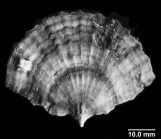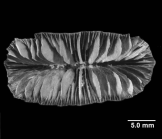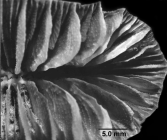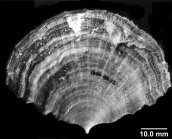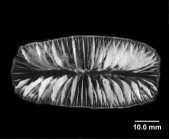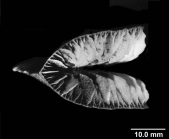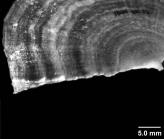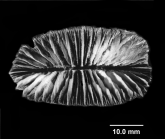| Introduction | | Species lists | | Search taxa | | Taxon tree | | Literature | | Distributions | | Statistics | | Editors | | Match taxa | | Webservice | | Log in |
WoRMS taxon detailsFlabellum Lesson, 1831
135114 (urn:lsid:marinespecies.org:taxname:135114)
accepted
Genus
Flabellum (Flabellum) pavoninum Lesson, 1831 (type by subsequent designation)
Flabella Duncan, 1864 · unaccepted > junior subjective synonym
marine,
recent + fossil
Lesson, R.P. 1831. Illustrations de zoologie ou recueil de figures d'animaux peintes d'apres nature, pls. 1-60. Bertrand, Paris., available online at http://www.biodiversitylibrary.org/item/91260 [details]
(of Flabella Duncan, 1864) Duncan PM. (1864). A description of some fossil corals and echinoderms from the South-Australian Tertiaries. <em>Annals and Magazine of Natural History, Series 3.</em> 14: 161-168, pls. 5-6. [details]
Depth range 36-2260 m
Depth range 36-2260 m [details] Description Cosmopolitan genus of non-reef building scleractinia. Solitary, free-living corals that are purse-shaped with or without...
Description Cosmopolitan genus of non-reef building scleractinia. Solitary, free-living corals that are purse-shaped with or without rootlets. Seta are very fine and numerous. Columellae are absent or nearly so. Polyps are extended day and night and are large, like Tubastraea (Veron, 1986 <57>). [details] Fossil range Eocene to Recent
Fossil range Eocene to Recent [details]
Hoeksema, B. W.; Cairns, S. (2025). World List of Scleractinia. Flabellum Lesson, 1831. Accessed through: World Register of Marine Species at: https://www.marinespecies.org/aphia.php?p=taxdetails&id=135114 on 2025-07-15
Date action by 2006-09-12 06:54:36Z changed Martinez, Olga
Nomenclatureoriginal description
Lesson, R.P. 1831. Illustrations de zoologie ou recueil de figures d'animaux peintes d'apres nature, pls. 1-60. Bertrand, Paris., available online at http://www.biodiversitylibrary.org/item/91260 [details] original description (of Flabella Duncan, 1864) Duncan PM. (1864). A description of some fossil corals and echinoderms from the South-Australian Tertiaries. <em>Annals and Magazine of Natural History, Series 3.</em> 14: 161-168, pls. 5-6. [details] basis of record Cairns, S.D., Hoeksema, B.W., and J. van der Land, 2001. Scleractinia, <B><I>in</I></B>: Costello, M.J. <i>et al.</i> (Ed.) (2001). <i>European register of marine species: a check-list of the marine species in Europe and a bibliography of guides to their identification. Collection Patrimoines Naturels,</i> 50: pp. 109-110 (look up in IMIS) [details] Taxonomyredescription
Cairns, S.D. (2000). A revision of the shallow-water azooxanthellate Scleractinia of the western Atlantic. <em>Studies on the Natural History of the Caribbean Region.</em> 75: 1-231. [details] Available for editors redescription Cairns, S.D. (1989). A revision of the ahermatypic Scleractinia of the Philippine Islands and adjacent waters, Part 1: Fungiacyathidae, Micrabaciidae, Turbinoliinae, Guyniidae, and Flabellidae. <em>Smithsonian Contributions to Zoology.</em> 486: 1-136. [details] Available for editors Otheradditional source
Neave, Sheffield Airey. (1939-1996). Nomenclator Zoologicus vol. 1-10 Online. <em>[Online Nomenclator Zoologicus at Checklistbank. Ubio link has gone].</em> , available online at https://www.checklistbank.org/dataset/126539/about [details]
additional source Veron JEN. (1986). Corals of Australia and the Indo-Pacific. <em>Angus & Robertson Publishers.</em> [details] additional source Moseley, H.N. (1876). Preliminary report to Professor Wyville Thompson, F.R.S., Director of the Civilian Scientific Staff, on the true corals dredged by H.M.S. 'Challenger' in deep water between the dates Dec. 30th, 1870, and August 31st. <em>Proc. R. Soc.</em> 24: 544-569. page(s): 546, 547, 566, 567, 568 [details] additional source Daly, M.M., Fautin D.G., Cappola V.A., 2003. Systematics of the Hexacorallia (Cnidaria: Anthozoa). Zoological Journal of the Linnean Society 139 3: 419-437. page(s): 424-425, 427-428 [details] Available for editors additional source Randall RH. (2003). An annotated checklist of hydrozoan and scleractinian corals collected from Guam and other Mariana Islands. <em>Micronesica.</em> 35-36: 121-137. page(s): 136 [details] additional source Moseley, H.N. 1877. Of the colouring matters of various animals, and especially of deep-sea forms dredged by H.M.S. Challenger.-- Quarterly Journal of Microscopical Science, new ser., 17: 1-23. page(s): 4 [details] additional source Durham JW. (1947). Corals from the Gulf of California and the north Pacific Coast of America. <em>Memoirs of the Geological Society of America.</em> 20: 1-68. page(s): 4 [details] additional source Cairns, S.D., L. Gershwin, F.J. Brook, P. Pugh, E.W. Dawson, O.V. Ocaña, W. Vervoort, G. Williams, J.E. Watson, D.M. Opresko, P. Schuchert, P.M. Hine, D.P. Gordon, H.I. Campbell, A.J. Wright, J.A.Sánchez & D.G. Fautin. (2009). Phylum Cnidaria: corals, medusae, hydroids, myxozoans. <em>in: Gordon, D.P. (Ed.) (2009). New Zealand inventory of biodiversity: 1. Kingdom Animalia: Radiata, Lophotrochozoa, Deuterostomia.</em> :59-101., available online at https://repository.si.edu/handle/10088/8431 [details] Available for editors additional source Wells JW (1971) Notes on Indo-Pacific scleractinian corals. Part 7. Catalaphyllia, a new genus of reef corals. Pacific Science 25: 368-371. page(s): 369 [details] additional source Milne Edwards H, Haime J. (1857). Histoire naturelle des coralliaires ou polypes proprement dits 2. Librairie Encyclopédique de Roret, Paris. 631 pp., available online at https://www.biodiversitylibrary.org/page/12403706 [details] additional source Chevalier J-P. (1961). Recherches sur les Madreporaires et les formations recifales Miocenes de la Mediterranee occidentale. <em>Memoires de la Societe Geologique de France, Nouvelle Série.</em> 40(93): 1-562, pls. 1-26. [details] additional source Verrill AE. (1869). Synopsis of the polyps and corals of the North Pacific Exploring Expedition, under Commodore C. Ringgold and Capt. John Rodgers, U.S.N., from 1853 to 1856. Collected by Dr. Wm. Stimpson, Naturalist to the Expedition. <em>Communications of the Essex Institute, Salem.</em> 6 (1): 51-104, pls. 1-2., available online at https://doi.org/10.1086/270634 page(s): 103 [69] [details] additional source Alcock AW. (1902). Report on the deep-sea Madreporaria of the Siboga-Expedition. <em>Siboga Expeditie.</em> 16a: 1-52, pls. 1-5., available online at https://doi.org/10.5962/bhl.title.11383 page(s): 31, 50 [details] additional source Squires DF. (1961). Deep sea corals collected by the Lamont Geological Observatory. 2. Scotia Sea corals. <em>American Museum Novitates.</em> 2046: 1-48. page(s): 2, 4, 6, 29 [details] additional source Yabe H, Eguchi M. (1942). Fossil and Recent Flabellum from Japan. <em>Science Reports of the Tohoku Imperial University, 2nd Series (Geology).</em> 22 (2): 87-103, 4 pls. [details] additional source Yabe H, Eguchi M. (1932). A study of the recent deep-water coral fauna of Japan. <em>Proceedings of the Imperial Academy of Japan.</em> 8: 387-390. page(s): 388 [details] additional source Cairns, S.D. (1989). Discriminant analysis of Indo-West Pacific Flabellum. <em>Memoirs of the Association of Australasian Palaeontologists.</em> 8: 61-68. page(s): 63, 67 [details] Available for editors additional source Verrill, A. E. (1868-1870). Review of the corals and polyps of the west coast of America. <em>Transactions of the Connecticut Academy of Arts and Sciences.</em> 1, 6, 377-558. page(s): 513, 535 [details] additional source Marenzeller, E. V. (1904). Stein- und Hydro-Korallen. XXXIII Reports on the dredging operations ? by the U. S. Fish Commission Steamer "Albatross". Bulletin of the Museum of Comparative Zoology (Harvard University), 43(2): 75-87 page(s): 81 [details] additional source Megina, C.; Conradi, M.; Piraino, S. (2003). Biodiversity, life cycles, and reproductive biology of deep-sea cnidarians. Berichte zur Polarforschung, 470, 108-112 page(s): 110 [details] additional source Gass, S. E.; Willison, M. J. H. (2005). An assessment of the distribution of deep-sea corals in Atlantic Canada by using both scientific and local forms of knowledge. André Freiwald and J. Murray Roberts (eds.). Springer. Verlag Berlin Heidelberg, pp. 223-245 page(s): 223, 229, 230, 232, 233, 234 [details] additional source Mortensen, P. B.; Buhl-Mortensen, L. (2005). Deep-water corals and their habitats in The Gully, a submarine canyon off Atlantic Canada. André Freiwald and J. Murray Roberts (eds.). Springer. Verlag Berlin Heidelberg, pp. 247-277 page(s): 258, 259, 262, 265 [details] additional source Smith FGW. (1954). Gulf of Mexico Madreporaria. <em>Fisheries Bulletin of the Fish and Wildlife Service (U.S.).</em> 55, 291-295. page(s): 294 [details] additional source Reed, J. K.; Weaver, D. C.; Pomponi, S. A. (2006). Habitat and fauna of deep-water Lophelia pertusa coral reefs off the southeastern U.S.: Blake Plateau, Straits of Florida, and Gulf of Mexico. Bulletin of Marine Science, 78, 2, 343-375 page(s): 346, 371 [details] additional source Dunn, D. F. (1982). Cnidaria. McGraw-Hill Book Company. New York and other cities., volume 1, pp. 669-706 page(s): 701 [details]  Present Present  Inaccurate Inaccurate  Introduced: alien Introduced: alien  Containing type locality Containing type locality
Nontype ZMAN, geounit Indonesian Exclusive Economic Zone [details]
Unknown type BMNH 1950.1.11.30, geounit South African Exclusive Economic Zone [details]
Unknown type USNM 20702, geounit United States Exclusive Economic Zone [details]
Unknown type USNM 20705, geounit United States Exclusive Economic Zone [details]
Unknown type USNM 20706, geounit United States Exclusive Economic Zone [details]
Unknown type USNM 20707 [details]
Unknown type USNM 20708, geounit United States Exclusive Economic Zone [details]
Unknown type USNM 20710 [details]
Unknown type USNM 20711, geounit United States Exclusive Economic Zone [details]
Unknown type USNM 40724, geounit Philippine Exclusive Economic Zone [details]
Unknown type USNM 40725, geounit Philippine Exclusive Economic Zone [details]
Unknown type USNM 40733, geounit Philippine Exclusive Economic Zone [details]
Unknown type USNM 81946, geounit Philippine Exclusive Economic Zone [details]
Unknown type USNM 82133 [details]
Unknown type USNM 82134, geounit South African Exclusive Economic Zone [details]
Unreviewed
Biology azooxanthellate [details]Depth range 36-2260 m [details] Description Cosmopolitan genus of non-reef building scleractinia. Solitary, free-living corals that are purse-shaped with or without rootlets. Seta are very fine and numerous. Columellae are absent or nearly so. Polyps are extended day and night and are large, like Tubastraea (Veron, 1986 <57>). [details] Fossil range Eocene to Recent [details] Habitat Known from seamounts and knolls [details] |
